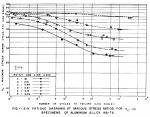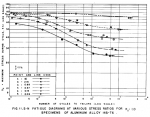A 1.5 safety factor is too low for rotor blades as the loads are too variable to accurately apply, larger safety factors are warranted.
I found this information in a Helicycle newsletter online.
"A picture of helicopter rotor blades probably won't get very many people overly excites. However that's not the case with the folks at Eagle R&D. To us, delivery of these blades means that a whole bunch of HELICYCLE's will soon be able to take to the air. Tooling up to produce certifies quality rotor blades for less than we sold then for at Rotorway in the late 80's had kept our noses to the grindstone.
The key quality feature is the 2024-T351 aluminum spar. In days gone by, 2024-T351 spars were simply purchased as extrusions and the price was reasonable. These days, if by some miracle you could find an extruder who would sell you a critical part like a rotor blade spar, their price would give you a heart attack. It's for this reason that most of the kit helicopter manufacturers now utilize some type of composite blade.
Don't get confused, there are a few kit helicopter blade spars and a lot of gyrocopter blade spars made from aluminum in the market place. The difference is these spars are extruded from 6061-T6 aluminum alloy. The centrifugal force loads on a gyro are lower so 6061-T6 might be used in this instance, although it is not the best material. To restate, in a powered shaft rotor, we must use 2024-T351 to meet the 8/1 safety factor required at the blade root. 6061-T6 does not have a high enough tensile strength to meet this requirement, given cross-sectional area, airfoil shape, blade C.G. and overall weight considerations.
Another key reason for the high cost 2024-T351 is that unlike the 6061-T6, it is a solution heat treated material. After extruding and preliminary straightening stretch, a 2 piece die is carefully wired around each part and it is heated up to 900 degrees F before being quenched in water, It is then aged prior to delivery. The customer must continue the straightening process with special tools and press fixtures tailored to his airfoil. 6061-T6 is extruded, stretched and aged, a much simpler process.
In order or provide a high quality, yet extremely low cost aluminum rotor, Eagle R&D had to take an alternative route. We had to find a way to machine our spars right from the certified quality billet and we had to do it quickly and inexpensively. In the past, companies like Boeing Vertol, Bell Helicopters and Eurocopter have machined their rotor blade spars on huge multi-million dollar planner mills. No one in the kit helicopter business that we know of has succeeded in this process because of the time and costs involved. It's taken us months of work, but the proof of the pudding is in the picture.
The issue of quality materials is only one of a multitude on non-compromises in the HELICYCLE. If forty years of helicopter flying has taught us one thing, it's that safety has no compromise. In addition, producing high quality in low volume at low cost is not just an oxymoron, it's a whole lot of mind bending, back breaking work, We Believe the HELICYCLE is worth it. !!"


